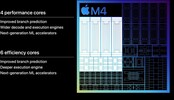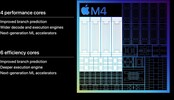Apple M4 (10 cores) vs Apple M4 (9 cores)
Apple M4 (10 cores)
► remove from comparison
The 10-core Apple M4 is an impressively fast ARM architecture processor (SoC) sporting 4 performance and 6 efficient CPU cores along with a 16-core neural engine and a 10-core GPU with hardware RT support and other modern features. On-package 7500 MT/s LPDDR5x RAM, USB 4 support and Thunderbolt 4 support are onboard as well, as are Wi-Fi 6E and Bluetooth 5.3.
The M4 debuted in May 2024 as part of an iPad launch event; its 4 performance cores run at up to 4.4 GHz, representing a healthy improvement over the M3 (10-core GPU) and its 4.06 GHz top clock speed. Besides, this new chip also has 6 efficient cores at its disposal that run at up to 2.9 GHz. The M3 had to make do with 4 performance cores and 4 efficient cores, for reference.
Architecture and Features
The new CPU cores run at faster clock speeds than what the M3 was capable of while also featuring some minor architectural improvements. A heavily customized version of ARM's v9.4-A microarchitecture is reportedly employed here. The M4 comes with on-package LPDDR5x-7500 RAM (120 GB/s) whereas the M3 was limited to 6400 MT/s. The updated NPU delivers up to 38 TOPS of performance for AI workloads.
Performance
In 2024 iPad Pros, the 3 nm chip is 10% to 20% faster than the M3 (10 GPU cores) in both multi-thread and single-thread short-term workloads. It also delivers about 10% higher multi-thread performance than the 9-core M4. This puts the 10-core part on an equal footing with the Ryzen 7 7745HX, Core i7-13705H and other higher-end x86 processors released in 2023 and 2024.
iPad Pros come with no active cooling solution however Mac minis and MacBook Pros do have one and the latest iMacs probably do as well. As our Fall 2024 Mac mini review shows, the M4's short-term performance doesn't benefit much from the presence of a fan, however its sustained performance benefits tremendously.
Graphics
The M4 GPU (10 cores) has hardware support for ray tracing as well as mesh shading and other modern technologies. It supports external displays with resolutions as high as 8K.
The graphics adapter runs at higher clock speeds than what the (otherwise identical) 10-core GPU built into the 9-core M4 can muster. As our Mac mini 2024 review confirmed, its performance is good enough to run many 2023 and 2024 games at 1080p on low or medium quality settings.
- Сyberpunk 2077 2.1 Phantom Liberty (1080p, Med): 28 fps
Much like it is with CPU performance, M4-powered iPad Pros will be much slower in long-term GPU-intensive workloads than iMacs, Mac minis and MacBook Pros due to the lack of proper cooling.
Power consumption
This specific M4 chip is found in 2024 iPad Pros, 2024 iMacs, 2024 Mac minis and 2024 MacBook Pros. Within the thin metal cases of the iPads - no active cooling - the chip's sustained power consumption hovers in the 4 W - 5 W area, with short-term peaks of up to 14 W possible. However, Mac minis and MacBook Pros do have an active cooling solution (and the new iMacs probably do, too) meaning the power consumption figures are several times higher. In our Fall 2024 Mac mini review, the SoC consumed 30 W to 40 W when under high loads.
The M4 is built with a "second generation" 3 nm TSMC process which is still cutting-edge as of late 2024.
Apple M4 (9 cores)
► remove from comparison
The 9-core Apple M4 is a rather fast ARM architecture processor (SoC) that sports 9 CPU cores, a 16-core neural engine and a 10-core GPU with hardware RT support and other modern features. Wi-Fi 6E and Bluetooth 5.3 as well as Thunderbolt 3 and USB 4 are all onboard, too. The M4 debuted in May 2024 as part of an iPad launch event; it has 3 performance cores running at a clock speed of up to 4.3 GHz and 6 efficient cores running at way under 3 GHz whereas the M3 (10 GPU cores) has 4 performance cores and 4 efficiency cores.
The faster 10-core M4 chip delivers 10% higher multi-thread performance and 15% higher graphics performance, to give you a rough figure. More importantly, the 10-core M4 can be had in systems with an active cooling solution, such as Fall 2024 MacBook Pros, whereas the 9-core one is an iPad Pro exclusive. Systems with a fan deliver much higher sustained performance than the ones without it.
Architecture and Features
The new CPU cores run at faster clock speeds than what the M3 was capable of and they also feature minor architectural improvements. The CPU cores are thought to be based on the ARM v9.4-A microarchitecture to a certain degree. The M4 comes with 16 GB or more (depending on the SKU) of on-package LPDDR5x-7500 RAM whereas the M3 was limited to 6400 MT/s. The updated NPU delivers up to 38 TOPS of performance for AI workloads.
Performance
Single-thread performance, multi-thread performance and NPU performance all got a noticeable boost compared to what we had with the M3 (10 GPU cores). The new processor is about 11% faster than the M3 in short-term multi-thread workloads while besting every M3 series chip possible in single-thread tasks by a comfortable margin. Geekbench 6.2 Multi puts the 9-core M4 right above the Core i9-13900H and the Ryzen 7 7840HS; in fact, the M4 is just 3% slower than Intel's top-of-the-line Core Ultra 9 185H chip. A 13% to 18% single-thread performance improvement over M3 series chips is evident if we look at Mozilla's Kraken test results. Octane V2 seems to think the M4 is just 4% slower than Intel's mighty Core i9-14900HX. CrossMark results suggest the M4 is about as fast as the Core i9-13900H.
The 10-core M4 is about 10% faster in multi-threaded tasks than the 9-core part is. It also delivers just slightly higher single-thread performance.
While Apple undoubtedly deserves some praise for what it managed to do here, it is important to highlight that all of the tests we did involve short-term workloads only. The M4 will suffer from heavy throttling if subjected to long-term workloads as there is no active cooling inside that super-thin iPad Pro case.
Graphics
The M4 GPU (10 cores) has hardware support for ray tracing as well as mesh shading and other modern technologies. It supports external displays with resolutions as high as "8K".
As far as performance is concerned, it appears the 9-core M4's GPU runs at significantly lower clock speeds than the (otherwise the same) GPU built into the 10-core M4 chip. This leads to a disappointing situation where what's supposedly a newer graphics adapter is about 10% slower than the 10-core GPU built into the M3. Still, this M4 GPU delivers very decent benchmark scores that put it in the same ballpark as the Radeon RX 6500M.
Power consumption
The chip's sustained power consumption is limited to ~7 W, with short-term peaks of up to 14 W possible.
The chip is built with a "second generation" 3 nm TSMC process that's still cutting-edge as of late 2024.
| Model | Apple M4 (10 cores) | Apple M4 (9 cores) | ||||||||||||||||||||||||||||||||||||||||||||||||||||||||
| Series | Apple M4 | Apple M4 | ||||||||||||||||||||||||||||||||||||||||||||||||||||||||
| Series: M4 |
|
| ||||||||||||||||||||||||||||||||||||||||||||||||||||||||
| Clock | 2890 - 4464 MHz | 2900 - 4400 MHz | ||||||||||||||||||||||||||||||||||||||||||||||||||||||||
| L2 Cache | 4 MB | 4 MB | ||||||||||||||||||||||||||||||||||||||||||||||||||||||||
| Cores / Threads | 10 / 10 4 x 4.5 GHz Apple M4 P-Core 6 x 2.9 GHz Apple M4 E-Core | 9 / 9 3 x 4.4 GHz Apple M4 P-Core 6 x 2.9 GHz Apple M4 E-Core | ||||||||||||||||||||||||||||||||||||||||||||||||||||||||
| TDP | 40 Watt | 9 Watt | ||||||||||||||||||||||||||||||||||||||||||||||||||||||||
| TDP Turbo PL2 | 40 Watt | 14 Watt | ||||||||||||||||||||||||||||||||||||||||||||||||||||||||
| Transistors | 28 Million | |||||||||||||||||||||||||||||||||||||||||||||||||||||||||
| Technology | 3 nm | 3 nm | ||||||||||||||||||||||||||||||||||||||||||||||||||||||||
| Features | Unified Memory LPDDR5X-7500 (120 GB/s), 16-Core Neural Engine, Media Engine (Encoding / Decoding: H.264, HEVC, ProRes, ProRes RAW, AV1 Decoding only) | Unified Memory LPDDR5X-7500 (120 GB/s), 16-Core Neural Engine, Media Engine (Encoding / Decoding: H.264, HEVC, ProRes, ProRes RAW, AV1 Decoding only) | ||||||||||||||||||||||||||||||||||||||||||||||||||||||||
| iGPU | Apple M4 10-core GPU | Apple M4 10-core GPU | ||||||||||||||||||||||||||||||||||||||||||||||||||||||||
| NPU / AI | 38 TOPS INT8 | 38 TOPS INT8 | ||||||||||||||||||||||||||||||||||||||||||||||||||||||||
| Architecture | ARM | ARM | ||||||||||||||||||||||||||||||||||||||||||||||||||||||||
| Announced |
Benchmarks
Average Benchmarks Apple M4 (10 cores) → 100% n=8
Average Benchmarks Apple M4 (9 cores) → 91% n=8
* Smaller numbers mean a higher performance
1 This benchmark is not used for the average calculation



